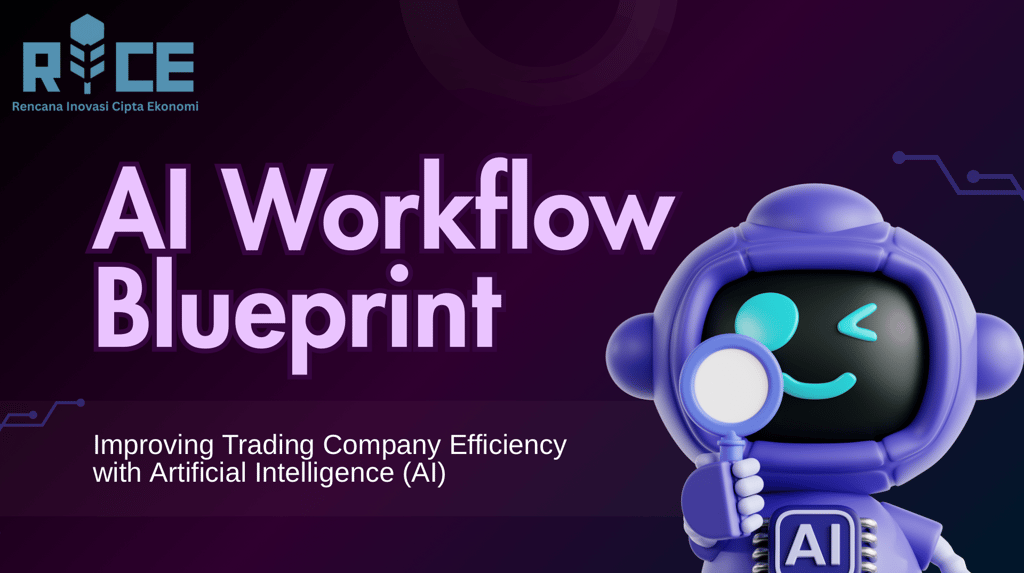Dynamic Routing Decoded: The Ultimate AI Blueprint for Real-Time Fulfillment Agility
This guide shows how intelligent algorithms and real-time data drive unprecedented fulfillment agility, cutting costs and boosting satisfaction.
INDUSTRIES
Rice AI (Ratna)
10/22/20257 min read


Are you prepared for the next era of logistics, where every delivery is optimized, every route is intelligent, and every customer interaction exceeds expectations? The demands on modern fulfillment operations have never been greater. Traditional, static routing methods are increasingly struggling to keep pace with the volatile, real-time nature of today's supply chains. This inability to adapt leads to inefficiencies, higher costs, and often, dissatisfied customers.
Enter dynamic routing, an advanced solution powered by artificial intelligence. This revolutionary approach isn't just an incremental improvement; it's a fundamental paradigm shift. It offers an AI blueprint for achieving unprecedented real-time fulfillment agility, transforming how goods move from warehouse to doorstep. This comprehensive guide will deep-dive into how AI-driven dynamic routing works, its foundational technologies, strategic implementation, and the profound benefits it delivers for logistics optimization.
Understanding the Core Challenge: The Static Nature of Traditional Routing
For decades, logistics operations relied on traditional, static routing. This involved pre-planned routes, often based on historical data, manual input, or rudimentary mapping software. Routes were typically established at the start of the day and largely adhered to, with only limited manual adjustments possible. While effective in simpler times, this methodology created significant vulnerabilities.
The inherent inflexibility of static routing meant operations struggled to respond to unforeseen real-time events. Sudden traffic congestion, unexpected road closures, vehicle breakdowns, urgent new orders, or even customer cancellations created immediate inefficiencies. Manual adjustments were time-consuming, prone to human error, and often suboptimal, leading to costly delays and increased fuel consumption. This rigid structure hindered true supply chain agility.
Such limitations translated directly into higher operational costs, including excessive fuel usage and unproductive driver hours. Furthermore, unpredictable delivery times and a lack of real-time communication significantly impacted customer satisfaction. In an increasingly on-demand world, the limitations of static routing are no longer sustainable, making a powerful case for intelligent, adaptive solutions to optimize last-mile delivery.
The AI Paradigm Shift: What is Dynamic Routing?
Dynamic routing represents a profound evolution from its static predecessors. At its core, dynamic routing is an AI-driven methodology that continuously optimizes delivery routes and schedules in real-time. It leverages a constant stream of live data to make intelligent decisions, ensuring maximum operational efficiency and responsiveness. Unlike static models, it doesn't just plan a route; it actively manages and re-optimizes it throughout the delivery process.
This approach integrates vast amounts of continuously updated information, including GPS data, real-time traffic conditions, weather forecasts, vehicle telematics, and instantaneous order modifications. By processing this complex data with advanced algorithms, dynamic routing systems can identify and implement the most efficient paths minute-by-minute. The system assesses numerous variables—from vehicle capacity and driver availability to delivery windows and customer priority—to generate optimal routes.
The primary objective is to maximize resource utilization while minimizing operational costs and delivery times. This leads to substantial improvements in service levels and customer satisfaction. Dynamic routing elevates route planning beyond simple navigation, offering a sophisticated, predictive, and adaptive framework for modern logistics optimization, fundamentally redefining real-time fulfillment.
Key AI Technologies Powering Dynamic Routing
The sophistication of dynamic routing hinges on the integration of several advanced AI technologies. These components work synergistically to process data, predict outcomes, and optimize decisions in milliseconds, forming the backbone of an intelligent AI blueprint for logistics.
Machine Learning and Predictive Analytics
Machine learning (ML) models are foundational to dynamic routing. These models continuously learn from vast historical and real-time datasets. They analyze patterns in past delivery times, driver performance, road conditions, and even seasonal demand fluctuations. This learning enables the system to make highly accurate predictions about future events. For instance, predictive analytics can anticipate traffic congestion based on time of day and specific routes, forecast potential weather delays, or even predict spikes in demand for certain regions or products. This foresight allows the system to proactively adjust routes before issues arise, minimizing disruptions. The ability to estimate precise arrival times, known as Estimated Time of Arrival (ETA), relies heavily on these sophisticated predictive capabilities, significantly enhancing transparency and customer satisfaction.
Optimization Algorithms
At the heart of dynamic routing are powerful optimization algorithms. These algorithms address complex problems, often variations of the Vehicle Routing Problem (VRP), which seeks the most efficient routes for a fleet of vehicles to deliver goods to a set of customers. Modern systems utilize advanced heuristic and meta-heuristic approaches to find near-optimal solutions rapidly, even with a massive number of variables. These algorithms consider multiple constraints simultaneously: vehicle capacities, specific delivery time windows, legal driver breaks, road restrictions, and customer priority levels. The goal is to balance these factors to achieve the most efficient use of resources while adhering to all operational requirements. This constant algorithmic recalculation is crucial for maintaining operational efficiency and supply chain agility.
Real-Time Data Integration
The efficacy of dynamic routing is directly proportional to its ability to ingest and process real-time data. This requires robust integration capabilities with various external and internal data sources. Internet of Things (IoT) sensors on vehicles provide live telematics data, including location, speed, and engine performance. GPS tracking offers precise vehicle positioning. External APIs feed in up-to-the-minute traffic information, weather conditions, and road incident alerts. Order management systems supply constant updates on new orders, cancellations, or modifications. This continuous influx of live data feeds the ML models and optimization algorithms, enabling instantaneous route adjustments. A resilient and scalable data infrastructure is therefore paramount to ensuring that dynamic routing systems can perform at peak effectiveness, facilitating truly real-time fulfillment.
Implementing Dynamic Routing: A Strategic Blueprint
Adopting dynamic routing is a strategic initiative that requires careful planning and execution. It's not merely plugging in a new software; it involves transforming existing processes and fostering a data-driven culture. This AI blueprint outlines a phased approach for successful implementation, focusing on sustainable logistics optimization.
Phase 1: Assessment and Data Foundation
The journey begins with a thorough assessment of your current logistics operations. This involves mapping existing routing processes, identifying bottlenecks, and understanding current challenges related to real-time fulfillment. A critical step is to identify all relevant data sources—from order history and warehouse inventory to vehicle maintenance logs and driver schedules. Data quality is paramount for AI-driven systems; therefore, cleaning, standardizing, and integrating existing data into a unified platform is essential. Establishing a robust data foundation ensures that the AI models have accurate and reliable information to learn from and make decisions, which is vital for effective route optimization.
Phase 2: Technology Integration and Pilot
With a solid data foundation, the next step involves selecting and integrating the appropriate AI-powered dynamic routing platform. This decision should align with your specific operational needs and scalability requirements. Rice AI specializes in bespoke dynamic routing solutions, leveraging cutting-edge machine learning to tailor systems to unique operational demands. Our platform is designed for seamless integration, ensuring businesses unlock unprecedented levels of logistics optimization from day one.
A phased rollout, starting with a pilot program in a controlled environment, is highly recommended. This allows your team to familiarize themselves with the new system, identify potential issues, and refine configurations without disrupting the entire operation. Comprehensive training for dispatchers, drivers, and operational staff is crucial to ensure smooth adoption and maximize the system's benefits.
Phase 3: Scaling and Continuous Improvement
Once the pilot demonstrates success, you can proceed with scaling the dynamic routing solution across your entire fleet and operations. This phase is characterized by an iterative process of learning and refinement. Live operational data continuously feeds back into the AI system, further enhancing its machine learning models and optimization algorithms. Continuous monitoring of key performance indicators (KPIs) such as cost per delivery, on-time delivery rates, driver utilization, and fuel efficiency is essential. These metrics provide valuable insights for ongoing system adjustments and process improvements, ensuring sustained operational efficiency and a strong competitive advantage. Regular reviews help adapt the system to evolving market conditions and business growth.
Transformative Benefits and Future Outlook
The adoption of dynamic routing powered by AI offers a multitude of transformative benefits that extend far beyond simple route efficiency, positioning businesses for future success in real-time fulfillment.
Tangible Benefits
One of the most immediate and significant advantages is cost reduction. Dynamic routing optimizes routes to minimize mileage and idle time, leading to substantial fuel savings and reduced labor hours. It also extends the lifespan of vehicles through more efficient usage. Simultaneously, customer satisfaction dramatically improves with faster, more reliable deliveries and the ability to provide accurate, real-time tracking information and proactive communication regarding any changes. This transparency builds trust and loyalty. Furthermore, operational efficiency sees a boost through higher delivery density, better resource allocation, and a reduction in manual planning efforts. Beyond direct cost savings, dynamic routing contributes to sustainability by lowering carbon emissions due to optimized, shorter routes. Crucially, it imbues operations with unparalleled supply chain agility, allowing businesses to quickly adapt to disruptions—whether they are unforeseen traffic incidents, last-minute orders, or changes in weather conditions—ensuring business continuity and resilience.
The Future of Fulfillment
The trajectory of dynamic routing points towards an even more integrated and autonomous future. We can anticipate deeper integration with emerging technologies such as autonomous delivery vehicles and drones, where AI orchestrates complex multi-modal networks. Hyper-personalization of delivery will become standard, with systems anticipating customer preferences for delivery times and locations. Predictive analytics will evolve to encompass predictive demand shaping, influencing consumer behavior by optimizing delivery incentives. For businesses, embracing this technology is not just about keeping pace; it's about securing a vital competitive advantage in an increasingly sophisticated market. The enterprises that master the AI blueprint for dynamic routing today will be the leaders in tomorrow's agile and efficient fulfillment landscape.
Conclusion
Dynamic routing, driven by advanced artificial intelligence, is unequivocally more than just an operational upgrade; it represents a fundamental rethinking of logistics. It moves beyond static constraints to embrace a fluid, responsive model that is essential for achieving real-time fulfillment agility in today's demanding market. Businesses that integrate this AI blueprint can unlock significant cost efficiencies, elevate customer satisfaction, and build a remarkably resilient and adaptive supply chain agility. The strategic advantages are clear: reduced operational costs, improved service levels, and a substantial boost to overall operational efficiency. Early adoption of these intelligent systems offers a distinct competitive advantage, positioning organizations at the forefront of the logistics revolution.
Navigating this technological transformation can be complex, requiring specialized expertise in AI, data science, and logistics optimization. Rice AI empowers businesses to navigate this transformation with confidence. Our proven methodologies and advanced AI platforms are designed to provide a comprehensive AI blueprint for optimizing your entire fulfillment ecosystem, ensuring you're not just keeping pace, but leading the way in logistics optimization.
Ready to transform your logistics operations and achieve unparalleled fulfillment agility? Explore how Rice AI can craft a custom dynamic routing solution for your business today, setting a new standard for efficiency and customer delight.
#DynamicRouting #AILogistics #RealTimeFulfillment #SupplyChainAgility #LogisticsOptimization #AIBlueprint #MachineLearning #PredictiveAnalytics #OperationalEfficiency #LastMileDelivery #FleetManagement #SmartLogistics #FulfillmentAgility #DigitalTransformation #RiceAI
RICE AI Consultant
To be the most trusted partner in digital transformation and AI innovation, helping organizations grow sustainably and create a better future.
Connect with us
Email: consultant@riceai.net
+62 822-2154-2090 (Marketing)
© 2025. All rights reserved.


+62 851-1748-1134 (Office)
IG: @riceai.consultant
